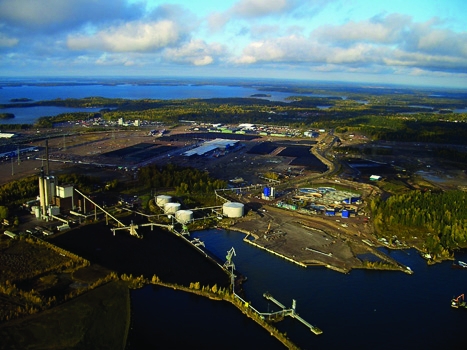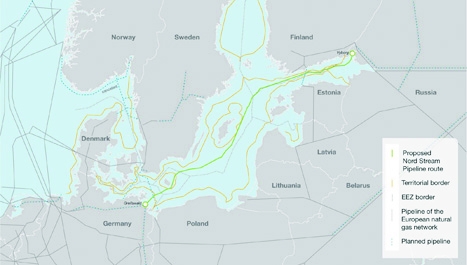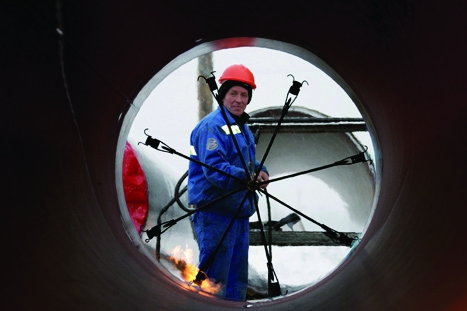
The presence of Russian state-owned energy giant, Gazprom, is never far away in the streets of Moscow. The company’s ’Dreams Come True’ motto permeates the city’s billboards, magazines and television adverts. But with many countries facing an energy shortage, its influence is now also beginning to creep its way into the western corners of Europe.
Today, the group owns the world’s largest gas reserves and produces a third of the planet’s natural gas. It maintains more than 445,000km of gas pipeline that spans central Europe to Asia. Over the past decade, increases in global energy demand have led to a tightening of the group’s grip on the lucrative gas market – a hold that it is now planning to strengthen with a massively ambitious €7.4bn (£4.8bn) project.
Known as Nord Stream, the project will be the largest subsea pipeline installation in the world. Over the next two years, engineers will lay down two parallel pipelines along the Baltic Sea to transport 55 billion cubic metres of gas throughout Europe each year. The 1,200km route will connect the Russian Baltic Sea coast from Portovaya Bay near Vyborg with the German Baltic Sea coast near Greifswald. Gazprom is in the driving seat with a 51 per stake in the project, which also includes partners Wintershall Holding, E.ON and Nederlandse Gasunie.

EU Energy commissioner Günther Oettinger has described Nord Stream as a ’priority’ and crucial in maintaining the European energy grid. Paul Corcoran, the financial director for the project, added that without Nord Stream, Europe will be facing a significant energy crisis. ’Beyond 2012-2013, there will be supply problems into Europe,’ he said. ’Even in the last cold snap, at one point the UK was down to one day’s reserve and very close to being without gas and without energy… North Sea production is tailing off very quickly and the back-up measures to replace the subsequent energy gap really aren’t there.’
“North Sea production is tailing off very quickly and the back-up measures to replace the subsequent energy gap really aren’t there”Paul Corcoran, finance director, Nord Stream
Despite agreement in the EU that Europe is in need of more gas supplies, the offshore route has caused concern among some countries that will be bypassed in Nord Stream’s plan. In 2006, the Polish foreign minister Radoslaw Sikorski compared the Nord Stream consortium to the 1939 Nazi-Soviet Pact and has since been outspoken in his opposition to the pipeline. His views stem from Russia’s historic use of gas a geopolitical weapon. In the past four years, Russia has shut off gas supplies in contract negotiations with Ukraine a number of times, affecting dozens of other countries in Europe during the height of winter.

However, Gazprom claims that the avoidance of transit countries on the Nord Stream route is not a political move and will enable it to reduce Russian gas transmission costs to Western Europe. Nord Stream AG, the project company of the consortium, has also dismissed criticism that an offshore route favours politics over economics. It said that over a period of 25 years, the Nord Stream pipeline will cost 15 per cent less than an onshore equivalent. The lower cost, the company added, is due the fact that underwater pipelines can transport more gas at higher pressures and take a more direct route.
But even if an offshore option is more economically sound, the Nord Stream consortium faces just as many engineering difficulties in choosing to build the pipeline offshore as it does political opposition from traditional transit countries. The unique diversity of the Baltic seabed means that the method of laying the pipes has to be continually adjusted. One of the biggest problems is the vast outcrops of hard rock along the northern part of the route. ’This is where the seabed is very uneven,’ explained Trond Gjedrem, engineering manager. ’If you imagine lots of small valleys along the seabed, there will be places where the pipeline will have a long unsupported free span. If this area is too long, we need to support it by placing rock between two higher peaks.’

In some areas, such as in shallow water and shipping routes, the difficulty of an uneven surface is overcome by burying the pipes in a pre-dredged trench. These methods require exact positioning of the pipes that is done using the S-lay technique. A dedicated lay barge is used to weld two 12m pipe joints together that are then fed on to the vessel’s main fabrication area and connected to the rest of the pipe string. As the pipeline moves across the stern of vessel and onto the seabed it is supported by a device called a stinger to minimise bending curvature and stress. Once two sections of pipe are in place, the barge is pulled forward 24m by its stern anchor cables and the process is repeated. Currently, Gjedrem estimates that an average 2.5km of pipeline is being laid per day.
However, the rate is not always this fast, explained Ruurd Hoekstra, deputy director of construction. ’The thing that not all people understand is that the Baltic is not as salty as the North Sea,’ he said. ’It has a delicate balance of salt water from the oceans and freshwater from the rivers. That means that the water freezes much faster… Our plan is to lay pipes throughout the year, but we also have to manage our operations based on the freezing conditions. So we have around six months in the northern part of the route where we cannot lay pipes at all.’
https://www.youtube.com/watch?v=tWttPEFIc6M
The unusual balance of salt water in the Baltic means that engineers also run a greater risk of upsetting the delicate balance of flora and fauna. To mitigate this, Nord Stream has conducted environmental impact studies that included analysis of more than 1,000 water and soil samples collected from 96 monitoring stations and observed the behaviour of fish, marine mammals and birds in an area covering more than 40,000km. Gjedrem believes the studies will be significant to both the project and the wider community. ’There has been a lot of knowledge that has been gained through all of this effort,’ he said. ’The value of this knowledge is more than €100m so it’s a huge programme. We will repeat all of this work to see the impact of the pipeline and we expect that the impacts will be very moderate, minor and very short term.’
But a more menacing concern is the danger posed by thousands of munitions that lie dormant on the Baltic seabed. After the Second World War, Allied countries took confiscated munitions from Germany and dumped them in the area. The situation was later compounded by the disposal of chemical warfare munitions by some Baltic Sea states in the early 1960s. According to some estimates, between 100,000 and 150,000 munitions currently lie in the Baltic, particularly around the Gulf of Finland. Some environmental groups are concerned that dislodging these munitions will damage the area’s sensitive ecosystem. But Nord Stream claims its extensive seabed surveys will remove the likelihood of this happening. Where possible, the group will reroute the pipe to avoid danger areas; however, around 80 munitions in Russian, Finnish and Swedish waters still need to be cleared in order for existing plans to go ahead.
“We expect that the impacts of the pipeline on flora and fauna will be very moderate, minor and very short term.”Trond Gjedrem, engineering manager, Nord Stream
Overcoming the challenges of munitions, ice and environmental concerns is a huge engineering and logistical feat. Nevertheless, construction of the Nord Stream pipeline has begun and is currently ahead of schedule. ’We’ve spent the past four years preparing for this moment,’ said Corcoran, ’From our point of view we are all very pleased how things have developed. In fact, it has gone better than planned. We are going full steam ahead. We’ve done all of the engineering, all of the design, all of the environmental work. Now that we’ve started construction, we will be building much faster offshore than we could onshore.’

During the official launch of construction last month, Russian president Dmitry Medvedev described the Nord Stream pipeline as another crucial link between Russia and Europe. ’Its construction meets our long-term goals,’ he said. ’And I would like to emphasise that it corresponds to the objective of developing our national economies. And, of course, this is our contribution into Europe’s energy security.’
Whether this link between Western Europe is at the expense of countries such as Poland, Ukraine and the Czech Republic is still a point that overshadows construction of the pipeline. But what is clear, is the EU needs to import significantly more gas to bridge the gap before renewables come on board. Even if the project does increase dependence of the UK on Russian gas imports, perhaps it is not such a high price to pay considering an alternative energy blackout situation.
Nord Stream’s seabed survey uncovered unexpected hurdles
It’s not only munitions that have been found at the bottom of the Baltic Sea as a result of the sea bed surveys. A dozen centuries-old shipwrecks have also been uncovered, many of which are unusually well preserved by the Baltic’s salty conditions.
Analysis so far has revealed that at least nine of the 12 findings are of great cultural historical value according to the Swedish National Heritage Board, which plans to register the shipwrecks as permanent ancient monuments.
The new findings were made in a 40-mile corridor east of the Swedish island of Gotland, which was originally hoped to be used for anchor positioning by the lay barge during the construction of the pipelines. The company said that construction work will be adapted so that the shipwrecks are unaffected.
Throughout the preparation phase of the project, Nord Stream has been working in close contact with the relevant Swedish authorities regarding the presence historical artefacts.
The documentation concerning the shipwrecks has been made available to the National Maritime Museums, which have prepared a final report on the survey documentation.
Göran Ankarlilja, a marine archaeologist at AquaArkeologen on Gotland, claims that the sea bed around Gotland has been only partially examined for marine artefacts, and that the number of these is still unknown. Historical sources from the last 250 years indicate that more than 2,500 ships have been wrecked around the island, but only around 100 wrecks have so far been found.
Baltic projects
The seabed of northwestern Europe is criss-crossed with pipes
» Nord Stream: 1,200km from Vyborg, Russia, to Greifswald, Germany. Operational by 2011
» Baltic Gas Interconnector: 200km from Rostock, Germany, to Avedore, Denmark. Operational by 2012
» Baltic Connector: 80-120km from Helsinki, Finland, to the Estonian coast. Ongoing seabed survey
» Baltic Pipe: 450km from Copenhagen, Denmark, to the Polish coast. Due to begin operating this year
» Danish Belts: 2 x 30km connecting Denmark’s Fyn province to Jutland and Sjaelland. Operational since 1984
» Oeresound: 74km from Dragor Denmark, to Limhamm, Sweden. Operational since 2006
» Estlink: 74km from Harku to Espoo, FInland. Operational since 2006
» Baltic Cable: 250km from Malmo, Sweden, to Lubeck, Denmark. Operational since 1994





Project to investigate hybrid approach to titanium manufacturing
What is this a hybrid of? Superplastic forming tends to be performed slowly as otherwise the behaviour is the hot creep that typifies hot...